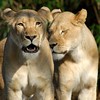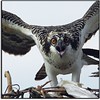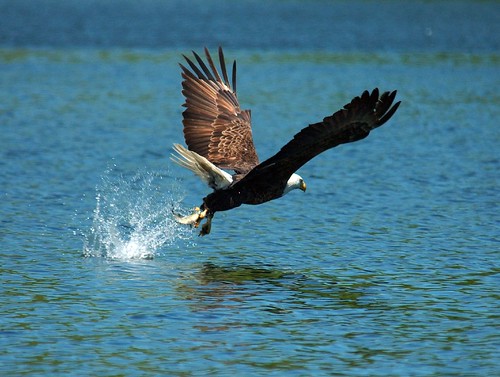On flickr I get asked frequently about the 80-400mm lens, and often share info freely with other photographers. It's probably got something to due with the flickr tag and the rank of some of my images for the 80-400mm f/4.5-5.6D VR. 



Of the top 60 images currently only 9 are NOT mine. Anyway, I'm writing this as a resource for more photographers to hopefully benefit from.
I've heard that the Nikkor (Nikon) 80-400mm D VR lens is the first VR lens that made by Nikon. I've had it for about 2 years now, have probably taken over 100,000 images with it. (I've got 4 dSLRs and am at around 180,000 clicks or so.)
Before I got the 80-400mm and again after I got it I read some reviews from various sources. Some reviewers liked it, others hated it and returned it within hours because it is "soft".
My take on the lens is that for the money (well under $2,000 US) it is a great lens for many reasons. Read the rest of my review/guide for what works well (and what doesn't), and how to get the most out of this lens.
To start, here's how I normally setup and shoot with the lens.
In General
Hand-Hold
As of May 2008 about 85% of my images are taken hand holding the lens. About 13% of my photos were taken with a monopod, and the remaining 2% are from a tripod. So, mostly I hand-hold with the lens.
AF-S
With my both my D200 and D300 I mostly shoot in continuous focus mode (AF-C) and tend to use just the center focus point (with group assist on the D200, or 13 or 21 or whatever point assistance on the D300. I try not to be too caught up in the technical exactness, as you may have wondered from that last sentence....
No Filters
UV - For quite some time I have not used a UV filter on this lens. I have gotten a minor mark on the front element as a result, but you cannot see it in any images. A UV filter is only useful in my mind for a protective cover over the lens while you're not using the lens. While on the lens it will add another piece of glass that will degrade image quality and possibly affect focus.
Circular Polarizer - For quite a while I used a Circular Polarizer with the lens. But for about a year now I've not. The same problem as the UV filter applies (see above) but there's a much worse problem with the CP filter. It blocks two stops of light. That's how a CP filter works, it blocks light from certain directions, to produce its effect. A Circular Polarizer filter can be great for landscapes, or setup shots. But for tracking wildlife, getting focus on a moving subject, you lose way too much light to make the effect worth it. At 400mm the lens is at f/5.6. This is the standard minimum f/stop that Nikon cameras are rated for to get accurate focus. With the polarizer on the minimum f/5.6 goes to about f/11 worth of light. Expecting a Nikon body to track focus at 2 stops under its recommended rating is asking too much, even in decent light. So, ditch the polarizer!
The next set of things I do are based on the available light.
Poor to Moderate Light
The down side to this lens is that it needs light. When light's not that great I shoot close to wide open at f/5.6 or f/6.3 in Aperture Priority mode. Then to get a decent shutter speed I boost ISO. In these lighting conditions I might shoot at ISO 400 to ISO 1000, or sometimes even higher. If you're worried about noise, answer this: Would you rather have a sharp-noisy image or a blurred noise-free image? All things being equal I prefer some noise to some blur. So I make sure I am shooting at a minimum of 1 over focal length over (ie 200mm = 1/200, or 400mm = 1/400). One way to come close to this is to shoot in Auto ISO at the D200 or D300's maximum shutter setting of 1/250th minimum. When doing this I set the ISO to around 400, and then let the ISO climb as needed probably to ISO 1600. Here are two decent examples of this at work:
ISO 1600 @ 1/100 and 230mm
ISO 900 @ 1/250th and 400mm
Good to Great Light
When the light is good, the lens is at its best. I will usually shoot at ISO 200 to ISO 400 and stop the lens down to a minimum of f/7.1 and for great light f/8 or f/11. Most of the time I will target a maximum shutter speed of about 1/1000th, and then give the rest of the light to the f/stop setting. I shoot in Aperture mode almost all the time. The problem I have with shooting in Shutter Mode in these conditions is if I set it to 1/1000 and that produces around f/9 and then I move on to a shaded area, or a cloud passes over, etc, I might be at f/5.6 and 1/1000th, not what I would pick. While Aperture mode alone won't fix this problem, I guess I am just used to shooting and adjusting the f/stop when the light changes... The main thing this lens needs to perform well is the right f/stop and a decent shutter speed.
These setting will apply to just about any camera and lens combination, but for me on my D200 and D300 here's what I do. Generally I shoot wildlife, birds, moving subjects, etc.
Camera Settings
AF-C - Continuous-Focus mode - For moving subject you have to be in AF-C. Simple as that.
AF-C and AF-S mode - These two settings can be found under a1 and a2 and they need to be set to Focus Priority. When in Release Priority the camera will let you take out of focus images. I want my images IN focus.
JPG Compression Mode I use JPGs about 98% of the time for my images, and the compression mode makes a huge difference. Be sure to have this set for Image Quality, NOT File Size. Also, if you want the best JPG image possible from the camera make sure the camera is set to Large and Fine. If you shoot in RAW these settings don't apply. For me, the extra file overheard and processing time is almost never worth it.
Misc
VR - 99% of the time I use the VR in position 1, which only activates the VR when an image is taken. The other mode enables preview with VR on when the shutter is half-pressed. The two problems with this is it uses more battery power, and when panning it can result in things creeping out of the frame before you take an image. When on a tripod for long exposures I will turn off VR, and when on a tripod with fast shutter speeds I often start with it off, and then try some with VR on too.
Back lit subject - When something that is back lit and the exposure is adjusted for the front of the subject, like a bird on a branch, the chromatic aberration can be very noticeable. There's not much you can do, stop down a little, and shoot RAW and adjust the aberration via the RAW plug-in.
Lens Hood - Most of the time I use the lens hood. It will prevent light from creeping in from the side and messing up the image. It also acts as a good alternative to a protective UV filter, preventing the front element from coming in contact with anything.
Hand holding - Two things you can do to improve your shots: 1) don't hold the lens from the front element. This moves during focusing, and if you are holding it, you can restrict the movement and the lens' ability to focus. 2) remove the tripod mount, or flip it upside down so you can get an even grip on the bottom of the lens.
Focus Limiter I keep the focus limiter enabled at all times, unless I need to focus at a close distance, and then I turn it off. To enable the focus limiter so that only things at a distance are in focus, and so it won't hunt at a close distance, start by focusing on something far away. Then rotate the ring at the front of the lens to A-L for Autofocus-Limit. Then move the slider on the side of the lens to L. One thing I've noticed is that to temporarily allow close focus is that you can click the switch on the side and you can focus on near subjects.
So, if you have under $2k for a 400mm lens I think this lens is a great choice. If you have $5-10k and don't mind shooting from a tripod a lot, get a 300mm f/2.8, or 400mm f/2.8 or 500mm f/4. I've considered getting all of those lenses but for now have held off. I like the mobility of the small 400mm. If I were to be going on Safari in Africa or somewhere in Alaska I'd seriously consider buying a bigger and faster lens, or even renting one... But until then I'm happy with the Nikkor 80-400mmD VR lens.
-Jon
![]()
Thursday, May 15, 2008
Nikkor 80-400mm VR - Get The Most Out Of This Lens
Subscribe to:
Post Comments (Atom)








14 comments:
Great article, Jon. I have been curious about that lens.
Good article, although it seems like you have much better luck with Aperture-priority mode than I do. It might have to do with the fact that I shoot in RAW rather than JPG, since the camera makes fewer adjustments for you.
But I appreciate the tips about the UV filter and having the VR at position 1 instead of 2. Both make a lot of sense, but I had been doing the opposite.
Can't wait to get a chance to try the new tips out.
Jon, I just discovered your blog - you have answered a number of questions (some I didn't even know I had). I am interested to learn that you shoot mostly hand-held...I ditched the UV filter and the polarizer may be next.
The 80-400mm lens sounds great. I use the 18-200 and am craving a wider angle.
Kate
Jon -
Thanks for the great review of the Nikkor 80-400mm AF.
I'm just starting out with my first DSLR Nikon D40/Nikkor 18-200mm AF-S.
I know the 80-400mm will not auto focus with my camera body, but do you know if it will meter with the D40.
I would love to purchase this lenses for my African safari in 2009.
Gman, I don't think you will be happy with the 80-400mm with a D40 and manual focusing.
You'd probably like the 300mm f/4 with a 1.4x TC instead better, and it's around the same price or cheaper I think as a combo vs. 80-400.
Jon, waht a great article.
I'm about 1/2 way through a 1 month rental on this same lens. I got frustrated with it and went back to my 70-200 with a 2x extender after a few days on vacation. I was considering returning the lens early but may reconsider after reading your tips. Maybe I haven't given it enough practice. I know the 200-400mm would be excellent in comparison but at 3 times the cost and weight, it would take a while before I could buy it and I'm not sure I could carry it when I did.
Thanks.
I found your blog after getting the 80-400mm VR and am so glad that I did. Your advice with this lens is spot on and has help me get some good photos.
Thanks for the info. I am abeginner and most of this was over my head, however, I am looking to buy a camera and lens and I was wondering if you could give me some ideas about what to purchase. I live on Whidbey Island, Wa and we have tons of eagles, hawks, osprey, owls, etc and I need a camera with a telephoto lens. I am considering a D90 and a Nikon AF 70-300mm VR. maybe get the 1.4x tc.
Any help much appreciated,
Christopher
Great article. I wish I could relate to some of those settings; however, I have a D90 and those options are not on mine. In answer to the post above me...I have been using the 70-300 and find is just so so. I've been looking to upgrade and am debating 70-200 2.8 (plus TC), 300 4.0 (plus TC), or this 80-400. Not thrilled with the higher ISO settings on the D90 at all so low light is a problem with the D90--the reason I'm looking for a hopefully faster zoom for wildlife.
Thanks for the tips!
Jane then you are not using the d90 properly as it is FAMOUS for its high iso performance. I've seen iso 1600 shots with it and they are amazing. I'm betting you haven't turned on NoiseReduction in your settings, amazes me how people afford cameras that I dream about yet don't know what they are doing with them.
Nikographer - I have you on flickr and have noticed you have upgraded to the 200-400mm. Now that you are in a different league and looking back in hindsight, do you still have the same feelings for the 80-400? is it still good or you got too frustrated with it and moved on? It's really the only handheld lightweight option for wildlife, but I might try and waight till they upgrade it to VR2 - Could be years though!
Phil, there are many reviews stating the D90 has issues beyond ISO 800. That is a problem when using lenses that are not the fastest (which is why I was asking about the other lenses). Shooting wildlife you need to keep as much detail as possible and I'm in so many different situations when shooting. The NR option I've experimented with and it's not the best when wanting the detail preserved. For wider (landscape) shots the higher ISO makes less of a difference.
I don't know where you have read that, the talk of the town is that the D90 is "low light king" as I quote from a newspaper title. I don't know what your expectations are as it's shown the D90=D300 up to ISO800 then outperforms it http://megaz.arbuz.com/2008/12/25/nikon-d300-vs-d90-high-iso-noise-comparison -quote:"However, starting from ISO 1600 and above, I noticed that D90 performs a little better in controlling noise.". If that is disappointing performance then I am sorry but there is not a camera in the world below 2k for you. There simply is not a better camera made (except D700 and ridiculous car-price pro cameras; not sure about canons) that handles high ISO better. Try to turn off D-lighting as well as not underexposing, that is known to cause noise. An equivalent Canon does the NR to the picture inside the camera for you without any control, imitating good ISO performance but with lost detail that you said you need. With Nikon they decided to let you decide if you want to lose detail or not.
Question about my af vr 80-400mm
Getting ready to send it in for repairs. I'm not sure if it's normal or not. with camera on and lens zoomed in "in the smallest position" if I press shutter release button halfway the lens zooms out about an inch or so and the only way to get in back in is to focus on something until it zooms back into the closed position. I understand it does move and thats normal but in order to get it back in this is what I have to do? Any input before I send it back to Nikon. Thanks!
Do I still like the 80-400mm? Yes, of course - I took a lot of great images with it, images I really like.
But, looking back and comparing it to the 200-400mm f/4.... I think first off, I realize that I must have damaged my 80-400 at some point. It grinds a slow grind when focusing back to front or the other way. And it is not just the slow gearing compared to internal focus of the 200-400mm.
A couple months ago at the zoo I lent someone my 200-400 for 5 minutes and I used their 80-400mm and their 80-400mm was much better than mine currently performs.
EZHighway, I guess it has been a while but, sounds like the camera might need fixing not the lens. IDK. Cleaning the contacts of the lens and camera might help.
I've sent all three of my Nikon's in for repair, and the D300 twice for focus problems and a cleaning. This last time they cleaned it but the focus is just slow compared to my D200 -which is weak since the D300 is uber better, right!?
And, not sure if I covered it above in detail, but don't ever use a converter on the 80-400mm - IT'S NOT WORTH IT!
I may do a 200-400mm f/4 VR review at some point, but I like it a lot, don't regret the purchase. It is a beast to handhold, and what I usually do is use a tripod when I can setup. For the airshows and fast planes I would use the tripod as a resting place for the lens in between hand-holding the planes in flight.
-J
Post a Comment